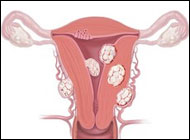New Clinical Trial to Examine Ways to Improve Treatment of Uterine Fibroids
Researchers at the University of Pennsylvania School of Medicine are working on ways to improve the results of a non-surgical method to treat fibroids. They are examining the overall effectiveness of different agents used to destroy uterine fibroids - a discovery that could lead to more answers about the durability of a procedure called Uterine Fibroid Embolization (UFE). It’s already been established throughout the medical community that, after a decade, UFE works to relieve the symptoms of fibroids. Now, in this new study, investigators want to learn how to optimize the procedure, by running a comparison of materials used during it.
“We already know that UFE has an 85-90% success rate, offering less complications and a shorter recovery time than surgical options,” Richard Shlansky-Goldberg, MD, Interventional Radiologist at Penn and Principal Investigator of this study, explains, “So in 2006, the question becomes, now that we know the procedure is effective and durable, ‘Which product would be better?’”
Uterine fibroids are benign (non-cancerous) tumors of the uterus that affect an estimated 20-40% of women, and for many, cause symptoms disrupting the quality of their lives. Uterine Fibroids affect more than six million women in the U.S. each year. The exact reason uterine fibroids (the most common type of abnormal growth in the uterus) develop is unknown, but medical researchers have associated the condition with genetics and hormones. If left untreated, uterine fibroids can cause infertility.
The treatment for uterine fibroids depends upon the size and location of the fibroids and the severity of symptoms. Uterine fibroid embolization (UFE), also known as uterine artery embolization (UAE), is a minimally invasive alternative to a hysterectomy and is a proven way to treat fibroids and relieve its symptoms of heavy bleeding, pressure, pain, and excessive urination.
Interventional radiologists don’t actually remove the fibroids during the UFE procedure. They shut them down and gradually shrink them, by blocking the blood supply to the fibroids. They do this by using a catheter to inject embolic agents (tiny plastic or sponge-like particles) into the artery, to “dam up” the blood flow to the fibroids. 
During this trial at Penn, several researchers will utilize two different embolic agents, comparing the outcomes in patients. 24 hours after each procedure, they will conduct an MRI to see how much fibroid tissue is destroyed. They’ll look again, when the patient leaves the hospital. Shlansky-Goldberg adds, “We hope to answer two questions. One - In looking at the different outcomes of each particle, does one do a more effective job of eliminating fibroids? And two - What does the uterus look like immediately after the UFE procedure and then later, after three months?”
This is a randomized, single-center study comparing Contour SE Microspheres to Embosphere Microspheres for treating symptomatic uterine fibroids with UFE. The head-to-head study at Penn, funded by Boston Scientific, will involve 60 patients. Penn is still enrolling patients in the study.
The clinical trial is expected to last about nine months.
University of Pennsylvania School of Medicine
Revision date: July 6, 2011
Last revised: by Janet A. Staessen, MD, PhD